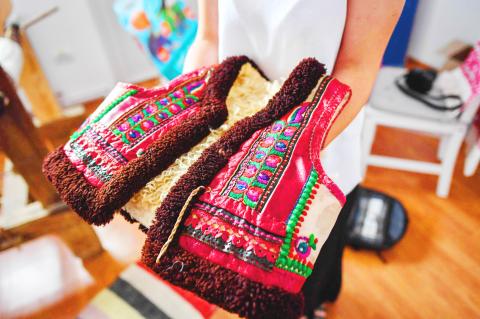They might feel aggrieved at not obtaining an official seal of approval, but traditional Romanian dressmakers are riding a wave of demand for their folk designs after a top fashion house inadvertently showcased their craft.
Clothes makers from Romania’s northwestern Bihor County were more than a little bemused when they got wind of a Christian Dior SE collection last year. Their jaws notably dropped when they saw an embroidered folk coat that looked strikingly similar to the cojocel binsenesc waistcoat their region has been producing for about a century.
A Romanian version of the garment, historically worn on important occasions, sells at home and abroad for about 500 euros (US$572) — almost a month’s salary in one of the EU’s poorest countries.

Photo: AFP
The Dior coat did not go unnoticed among the wider population either, after a resident of the regional city of Beius spotted it in a Singapore shop and posted it on Facebook, sparking a strong response from users, which was picked up by the media.
“That day, I posted my first comment on Facebook, thanking the Dior fashion house for appreciating this beautiful item,” said Dorina Hanza, a 52-year-old embroiderer who understood the similarity.
La Blouse Roumaine, which promotes the Romanian blouse to encourage women to wear it, juxtaposed the different versions side by side on Twitter with the hashtag #givecredit.
Yet Dior, which did not respond to requests for comment, might well have done the Bihor designers a favor.
Demand has soared since the social media posts pointing out the similarities between both versions of the heavily embroidered, multicolor, sheepskin sleeveless jacket with black fur edging.
“Since then, everybody wants one” from the traditional source, said Ana Florea, who runs a designers’ group in Beius, near the Hungarian border. “This waistcoat is 100 percent ours.”
Hanza, while happy to see the Romanian version in the limelight, said she just wished Dior could have given a nod to their apparent inspiration.
“They could have said: ‘We borrowed this from the Romanian people,’” Hanza said, adding that “the tradition might have been lost” had the current controversy not emerged.
Diana Naprodean, 44, also sees an upside to the Dior garment.
“That proves it’s really pretty,” said the librarian, a hobbyist crocheter and embroiderer who has just produced her own first attempt at the traditional waistcoat.
“Thanks Dior. Thanks to you we have begun to love our traditional costume again,” said 33-year-old Diana Herdelo, another member of the Beius group who is weaving one of her own.
The waistcoat is made from local Bihor sheepskin after a tanning process of about three weeks. It is then tailored and decorated with local-style embroidery and worn by both men and women, although the length and motifs differ.
With traditional regional costumes being worn by fewer and fewer people, demand for the clothes had almost died out until the controversy over the Dior jacket reignited interest.
However, one important detail on the Dior version did not escape the notice of Bihor residents — the jacket worn by the fashion model was adorned with motifs — a phallic symbol — strictly worn only by men.
“Tradition doesn’t allow a woman to wear a man’s cojocel or the other way around,” Hanza said.
With interest piqued, Romania’s Beau Monde magazine and advertising agency McCann have launched an ad campaign entitled “Bihor Couture,” along with a Web site where fans can order a jacket and other traditional items.
The site has already taken about 1,000 orders.
“Our goal is to help people in this region and showcase their work and their traditions, which were in danger of dying out,” former Beau Monde editor-in-chief Roxana Dobrita said.
McCann creative director for Romania Catalin Dobre said he believes that “the fashion industry should do more to support traditions.”
“Across the globe, the leading brands take their inspiration from different cultures without recognizing it,” he said in an e-mail.
Romanian Peasant Museum curator Horatiu Ilea said he believes any accusations against Dior in this case are unjustified.
“Culture is a living thing. Ideas get bounced around, you can’t stop that,” Ilea said, adding that “cultural appropriation” has been going on since ancient times.
Rather than demand some form of redress, Ilea urged Romania “to benefit from this incident, by, for example, launching a campaign promoting traditional and artisanal work.”

The Eurovision Song Contest has seen a surge in punter interest at the bookmakers, becoming a major betting event, experts said ahead of last night’s giant glamfest in Basel. “Eurovision has quietly become one of the biggest betting events of the year,” said Tomi Huttunen, senior manager of the Online Computer Finland (OCS) betting and casino platform. Betting sites have long been used to gauge which way voters might be leaning ahead of the world’s biggest televised live music event. However, bookmakers highlight a huge increase in engagement in recent years — and this year in particular. “We’ve already passed 2023’s total activity and

Nvidia Corp CEO Jensen Huang (黃仁勳) today announced that his company has selected "Beitou Shilin" in Taipei for its new Taiwan office, called Nvidia Constellation, putting an end to months of speculation. Industry sources have said that the tech giant has been eyeing the Beitou Shilin Science Park as the site of its new overseas headquarters, and speculated that the new headquarters would be built on two plots of land designated as "T17" and "T18," which span 3.89 hectares in the park. "I think it's time for us to reveal one of the largest products we've ever built," Huang said near the

China yesterday announced anti-dumping duties as high as 74.9 percent on imports of polyoxymethylene (POM) copolymers, a type of engineering plastic, from Taiwan, the US, the EU and Japan. The Chinese Ministry of Commerce’s findings conclude a probe launched in May last year, shortly after the US sharply increased tariffs on Chinese electric vehicles, computer chips and other imports. POM copolymers can partially replace metals such as copper and zinc, and have various applications, including in auto parts, electronics and medical equipment, the Chinese ministry has said. In January, it said initial investigations had determined that dumping was taking place, and implemented preliminary

Intel Corp yesterday reinforced its determination to strengthen its partnerships with Taiwan’s ecosystem partners including original-electronic-manufacturing (OEM) companies such as Hon Hai Precision Industry Co (鴻海精密) and chipmaker United Microelectronics Corp (UMC, 聯電). “Tonight marks a new beginning. We renew our new partnership with Taiwan ecosystem,” Intel new chief executive officer Tan Lip-bu (陳立武) said at a dinner with representatives from the company’s local partners, celebrating the 40th anniversary of the US chip giant’s presence in Taiwan. Tan took the reins at Intel six weeks ago aiming to reform the chipmaker and revive its past glory. This is the first time Tan